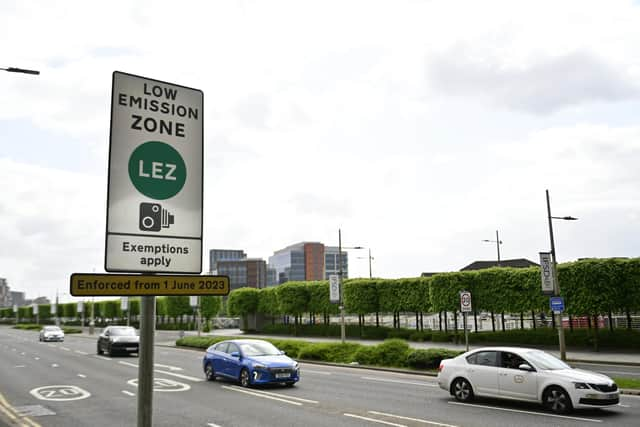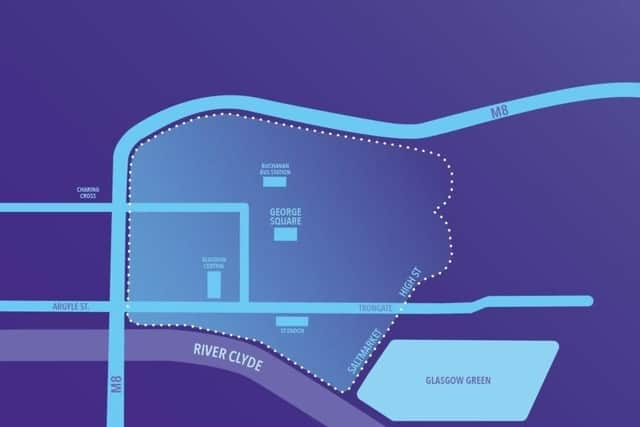Glasgow LEZ: Council chiefs had no legal justification for 'illegal' low emission zone, court told
Council chiefs had no proper legal justification to allow a “illegal” and “draconian” low emission zone (LEZ) scheme to operate in Scotland’s largest city, a court has heard.
Advocate Lord Davidson of Glen Clova KC told judge Lady Poole that Glasgow City Council acted unlawfully in allowing the initiative to come into being. He told the Court of Session on Tuesday the local authority had failed to follow established legal tests before making its decision to introduce the LEZ, which covers Glasgow City centre.
Advertisement
Hide AdAdvertisement
Hide AdThe second phase of the scheme, which started operating in June, aims to improve air quality in Glasgow city centre by limiting what vehicles can enter the area. Cars, lorries and other forms of transportation which do not meet emission guidelines are not allowed and drivers who break the regulations can be fined.


Lord Davidson said available data showed air quality in the city centre had been improving in recent years and this trend was set to continue. He said the information showed there was no need for an LEZ to be introduced in Glasgow.
Lord Davidson said Glasgow City Council’s decision to implement the scheme in the light of this available information was unlawful. He said the court should order a “reduction” of the council’s decision to establish the LEZ and stop it from continuing to operate.
“The submission is that the low emission zone scheme is illegal as air quality objectives have been met already and they were continuing to be met by the time the low emission zone was brought into operation in the city centre. To bring the scheme into being was an irrational decision by the council.”
Lord Davidson was speaking on the first day of a judicial review, which has been brought to Scotland’s highest civil court by his client, a company called Patons Accident Repair Centre. The firm, based in the city’s Townhead area, claims the scheme is unlawful.


The second phase of the LEZ came into force on June and it banned thousands of vehicles which do not meet emissions requirements from entering Glasgow city centre.
The company’s director William Paton has previously spoken of how he commissioned a report by the Hilson Moran Institute to study the impact of the first phase of the LEZ for buses in the city centre which came into force in 2018.
The report found air quality aims were achieved in phase one and the second phase impacting other vehicles would not lead to any further improvement in air quality.
Advertisement
Hide AdAdvertisement
Hide AdSpeaking earlier this year, Mr Paton said: “We started speaking to the council and outlined our personal and commercial concerns about the low emission zone, its necessity, and whether the data should be revisited. The independent expert analysis showed that phase two wasn't required.
"It showed that compliance had been achieved in 2022 with all Air Quality Scotland objectives. It showed a continuing downward trend with no further action at all from the natural renewing of older vehicles with cleaner ones without the requirement for a phase two. What stuck in our mind was that we were told if we got this to judicial review, we had a decent chance.
"There's evidence here to show that the public will be massively disaffected by this – massively.”
Other critics of the scheme say the LEZ will have a detrimental impact on Glasgow’s economy. The drummer with top Scots rock band Gun, Paul McManus, has contributed £100,000 to a campaign aimed at halting the scheme.
Mr McManus, who has also made financial donations to the Labour Party, said he wanted to get involved as he felt it would hit poorer people hardest.
On Tuesday, Lord Davidson told the court there were 27 monitoring stations in Glasgow City Centre that monitored levels of nitrogen dioxide (NO2) in the air – the gas which the local authority hopes to reduce in the air in the city centre.
Lord Davidson said 25 out of the 27 stations had recorded “downward trends” of NO2 in recent years. He said the two stations which hadn’t recorded the downward trends were located in Hope Street.
The advocate said the information available to the council meant that it shouldn’t have allowed the LEZ to operate in its present form. He said: “The council did not display a relevant understanding of the facts when making its decision to implement the scheme.
Advertisement
Hide AdAdvertisement
Hide Ad“There were no sufficient facts available to the council to demonstrate that the LEZ was meeting objectives. It is unreasonable of the council to have imposed an LEZ of the entire area because of the exceedences in these two areas. The council’s decision was unlawful.”
Lord Davidson also spoke in his submissions of how motorists could be fined hundreds of pounds if they repeatedly breached the LEZ. He said: “This is draconian.”
Glasgow City Council’s advocate Ruth Crawford KC told judge Lady Poole the local authority had acquired evidence about NO2 emissions which gave it a lawful justification to set up a LEZ.
Ms Crawford said the council had regard to different and more extensive types of data which showed that NO2 emissions were a continuing issue in Glasgow’s city centre.
She said this “modelling” gave the council a lawful basis to set up an LEZ.
Ms Crawford added: “In my submission that modelling cannot be properly criticised by the petitioner. It cannot be said by any stretch that the decision is irrational.
“Without a low emission zone there would be a continuing problem with exceedences. But with a low emission zone the air quality would be improved.”
The hearing continues on Wednesday when Ms Crawford continues her submissions and the Scottish Government’s lawyer Gerry Moynihan KC is also expected to address the court.
Comments
Want to join the conversation? Please or to comment on this article.